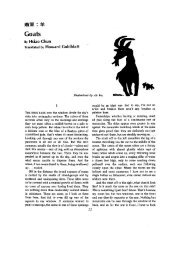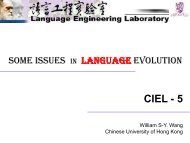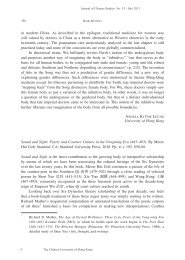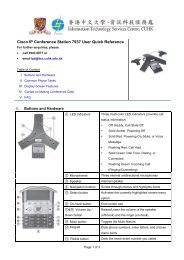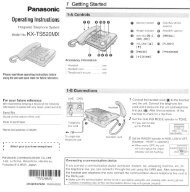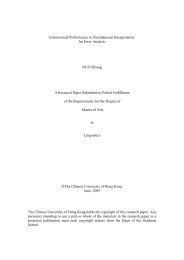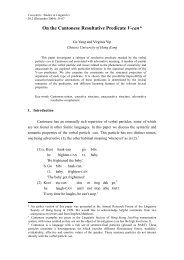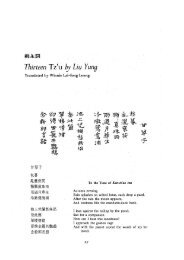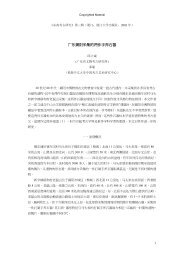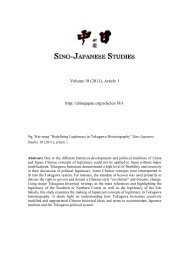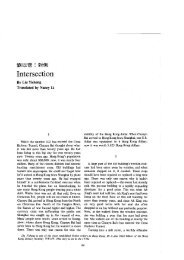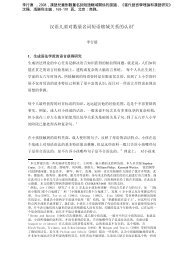Acquisition of Japanese Passives by Cantonese Speakers in Hong ...
Acquisition of Japanese Passives by Cantonese Speakers in Hong ...
Acquisition of Japanese Passives by Cantonese Speakers in Hong ...
You also want an ePaper? Increase the reach of your titles
YUMPU automatically turns print PDFs into web optimized ePapers that Google loves.
<strong>Acquisition</strong> <strong>of</strong> <strong>Japanese</strong> <strong>Passives</strong> <strong>by</strong> <strong>Cantonese</strong><br />
<strong>Speakers</strong> <strong>in</strong> <strong>Hong</strong> Kong<br />
WONG Yat-yu<br />
A Research Paper Submitted <strong>in</strong> Partial Fulfillment<br />
<strong>of</strong> the Requirements for the Degree <strong>of</strong><br />
Master <strong>of</strong> Arts<br />
<strong>in</strong><br />
L<strong>in</strong>guistics<br />
@ The Ch<strong>in</strong>ese University <strong>of</strong> <strong>Hong</strong> Kong<br />
June 2007<br />
The Ch<strong>in</strong>ese University <strong>of</strong> <strong>Hong</strong> Kong holds the copyright <strong>of</strong> this research<br />
paper. Any person(s) <strong>in</strong>tend<strong>in</strong>g to use a part or whole <strong>of</strong> the materials <strong>in</strong> the<br />
research paper <strong>in</strong> a proposed publication must seek copyright release from<br />
the Dean <strong>of</strong> the Graduate School.
Abstract<br />
The paper aims at <strong>in</strong>vestigat<strong>in</strong>g <strong>Cantonese</strong> native speakers’ <strong>Japanese</strong> <strong>in</strong>terlanguage (JIL).<br />
It studies how <strong>Japanese</strong> passives and the related topic structures are<br />
successfully/unsuccessfully acquired <strong>by</strong> <strong>Cantonese</strong> native speakers, who learn English<br />
as second language (L2) and <strong>Japanese</strong> as third language (L3) <strong>in</strong> <strong>Hong</strong> Kong. In previous<br />
studies, acquisition <strong>of</strong> <strong>Japanese</strong> passives and topic structures <strong>by</strong> <strong>Cantonese</strong> speakers is<br />
seldom <strong>in</strong>vestigated. One important related study is <strong>by</strong> Yip (1995), who suggests that<br />
pseudo-passives can be analyzed as transfer <strong>of</strong> topic structures from Ch<strong>in</strong>ese to Ch<strong>in</strong>ese-<br />
English <strong>in</strong>terlanguage (CIL), because Ch<strong>in</strong>ese speakers are <strong>in</strong>fluenced <strong>by</strong> their mother<br />
tongue, which is a topic-prom<strong>in</strong>ence language. She further discusses the learnability<br />
problems posed <strong>by</strong> pseudo-passives <strong>in</strong> the <strong>in</strong>terlanguage: the existence <strong>of</strong> pseudo-<br />
passive <strong>in</strong> CIL can be seen as under-generation <strong>of</strong> passives on the one hand, and over-<br />
generation <strong>of</strong> topic structures on the other. Based on Yip’s research, the present study<br />
<strong>in</strong>vestigates how <strong>Japanese</strong> learners acquire passive structures and if they over-generate<br />
topic structures <strong>in</strong> JIL. The experiment consists <strong>of</strong> a grammaticality judgment task and a<br />
picture description task, which are designed to test <strong>Cantonese</strong> speakers’ knowledge <strong>of</strong><br />
passives and topic structures. The results <strong>of</strong> the experiment suggest that niyotte passives<br />
and <strong>in</strong>transitive <strong>in</strong>direct passives are difficult for both advanced and <strong>in</strong>termediate level<br />
learners to acquire. These can be expla<strong>in</strong>ed <strong>by</strong> the uniqueness <strong>of</strong> niyotte passives which<br />
are different from the other languages; and the negative L1 transfer <strong>in</strong> <strong>in</strong>transitive<br />
<strong>in</strong>direct passives. Moreover, unlike over-generation <strong>of</strong> topic structures <strong>in</strong> CIL, the L2<br />
learners under-generate topic structures <strong>in</strong> JIL. It is possible that the L2 learners are<br />
<strong>in</strong>fluenced <strong>by</strong> the knowledge <strong>of</strong> English that subjects are obligatory <strong>in</strong> topic structures.<br />
i
提要<br />
本論文主要研究以廣東話為母語者的日語中間語言。研究對象以英語為第二語<br />
言,再學習日語為第三語言。研究的重點在於學習者是否成功習得日語的被動式<br />
及與其相關的主題結構語法。在以往的研究成果中甚少提及以廣東話為母語者習<br />
得日語被動式及主題結構語法的情況。其中一項與本論文相關的重要研究是葉彩<br />
燕的論文。葉提出假被動式出現在英語中間語言,可分析為以中文為母語者將中<br />
文的主題結構語法轉移到英語被動式。這是因為他們受母語影響,而中文是主題<br />
結構突出的語言。她進一步提出假被動式的出現是因為學習者將英文被動式特殊<br />
化,同時將英文的主體結構語法概括化。在葉的研究基礎上,本論文主要研究日<br />
語中間語言中的學習者習得被動式的情況與他們是否將主題結構語法概括化。研<br />
究的實驗包括了文法判斷與看圖作句,以測試學習者對日語被動式及主題結構語<br />
法的認識。實驗結果主要有以下兩點:首先,中上級學習者在習得niyotte被動式<br />
與非及物間接被動式上有困難。這是由於獨特的niyotte被動式與其他語言相異;<br />
以及第一語言對學習非及物間接被動式的負面影響。此外,學習者雖然在英語中<br />
間語言中將主體結構語法概括化,卻在日語中間語言中將其特殊化。這可能是因<br />
為學習者受到英語中主題結構句子必須要有主語的知識所影響。<br />
ii
Acknowledgements<br />
I would like to express my heartfelt thanks to my dissertation supervisor, Pr<strong>of</strong>. Yip<br />
Choy-y<strong>in</strong> Virg<strong>in</strong>ia, for her guidance and help with my research. I deeply appreciate her<br />
patience and k<strong>in</strong>dness. With her valuable suggestions and criticism, I have worked out<br />
this project.<br />
I am thankful to my many friends from <strong>Japanese</strong> Studies department. They are<br />
generous to give me different op<strong>in</strong>ions about <strong>Japanese</strong>. I must also say “thank you very<br />
much” to Pr<strong>of</strong>. Ho Chi-m<strong>in</strong>g and Ms Kong Sung Tak, the <strong>Japanese</strong> teachers at the<br />
university, for their most k<strong>in</strong>d advice.<br />
I would also like to express my appreciation to all <strong>Japanese</strong> learners who did the<br />
experiment <strong>of</strong> the project. Without their k<strong>in</strong>d help, the project would not be worked out.<br />
years.<br />
Last but not least, I want to say “thank you!’ to my parents who support me over the<br />
iii
Table <strong>of</strong> Contents<br />
Abstract (English)…………………………………………………………………....…i<br />
Abstract (Ch<strong>in</strong>ese)……………….…………………………………………………......ii<br />
Acknowledgement ...……………………………………………………………...…...iii<br />
Table <strong>of</strong> Contents……………….………………………………………………..……iv<br />
1. Introduction……………………………...……………………………………..1<br />
1.1 Previous Research…………………………………………………………..1<br />
1.1.1 Studies on the <strong>Acquisition</strong> <strong>of</strong> <strong>Japanese</strong> <strong>Passives</strong>…….…………….....1<br />
1.1.2 Studies on the <strong>Acquisition</strong> <strong>of</strong> English <strong>Passives</strong> <strong>by</strong> Ch<strong>in</strong>ese Learners..2<br />
1.2 Theory <strong>of</strong> Interlanguage………………...………………………………….3<br />
2. Passive and Topic Constructions……………………………………………….4<br />
2.1 Passive Constructions <strong>in</strong> <strong>Cantonese</strong>, <strong>Japanese</strong> and English………………..4<br />
2.1.1 Passive Constructions <strong>in</strong> <strong>Cantonese</strong>………………………………..4<br />
2.1.2 Passive Constructions <strong>in</strong> <strong>Japanese</strong>………………………………….6<br />
2.1.3 Passive Constructions <strong>in</strong> English…………………………………...9<br />
2.2 Topic Constructions <strong>in</strong> <strong>Cantonese</strong>, <strong>Japanese</strong> and English………………...10<br />
2.2.1 Topic Constructions <strong>in</strong> <strong>Cantonese</strong>………………………………...10<br />
2.2.2 Topic Constructions <strong>in</strong> <strong>Japanese</strong>…...……………………………..11<br />
2.2.3 Topic Constructions <strong>in</strong> English………………………………...…12<br />
2.3 Research Hypotheses……………………………………………………...13<br />
3. Research Methodology………………………………………………………..14<br />
3.1 Subjects……………………………………………………………………14<br />
3.2 Test Design………………………………………………………………..15<br />
3.2.1 The Grammaticality Judgment (GJ) Task……………………...…15<br />
3.2.2 The Picture Description (PD) Task…………...…………………..19<br />
3.3 Experimental Procedure and Test Scor<strong>in</strong>g……...………………………...20<br />
3.3.1 Pilot Study……...…………………………………………………20<br />
3.3.2 Native Control………...…………………………………………..20<br />
3.3.3 Implementation……………………………………………………21<br />
3.3.4 Data Analysis……………………………………………………...21<br />
iv
4. Results and Discussion………………………………………………………..22<br />
4.1 Results <strong>of</strong> the Grammaticality Judgment (GJ) Task………………………22<br />
4.2 Results <strong>of</strong> the Picture Description (PD) Task……………………………..24<br />
4.3 Overall Results and Discussion…………………………………………...25<br />
5. Conclusion…………………………………………………………………….28<br />
References………………...………………………………………………………30<br />
Appendix A: Grammaticality Judgment Task………………………………….....34<br />
Appendix B: Picture Description Task…………………………………………...39<br />
Appendix C: Translation <strong>of</strong> Grammaticality Judgment Task……………………..43<br />
Appendix D: Translation <strong>of</strong> Picture Description Task…………………………....52<br />
v
1. Introduction<br />
The research aims at <strong>in</strong>vestigat<strong>in</strong>g <strong>Cantonese</strong> native speakers’ <strong>Japanese</strong><br />
<strong>in</strong>terlanguage (JIL). We <strong>in</strong>vestigate the extent to which <strong>Japanese</strong> passives and the<br />
related topic structures are successfully acquired <strong>by</strong> <strong>in</strong>termediate and advanced<br />
learners. S<strong>in</strong>ce the subjects learn English as second language (L2) and then <strong>Japanese</strong><br />
as third language (L3), both roles <strong>of</strong> first language (L1) and L2 transfer are<br />
discussed. Moreover, Yip f<strong>in</strong>ds out that the existence <strong>of</strong> pseudo passive <strong>in</strong> Ch<strong>in</strong>ese<br />
English <strong>in</strong>terlanguage (CIL) is due to the learners over generalize the topic structure<br />
and under generalized the passives. Based on Yip’s research, the study aims at<br />
f<strong>in</strong>d<strong>in</strong>g out if the <strong>Japanese</strong> learners also over generalize the topic structure.<br />
In the present study, an experiment is designed consist<strong>in</strong>g <strong>of</strong> a grammaticality<br />
judgment task and a picture description task. The tasks are designed to test the JIL <strong>of</strong><br />
<strong>Cantonese</strong> native speakers. Two different levels <strong>of</strong> learners are recruited as the<br />
subjects <strong>of</strong> the study, <strong>in</strong>clud<strong>in</strong>g <strong>in</strong>termediate and advanced level.<br />
After the <strong>in</strong>troduction <strong>in</strong> section one, the passives and topic constructions <strong>in</strong><br />
<strong>Cantonese</strong>, <strong>Japanese</strong> and English are discussed <strong>in</strong> section two. Information on the<br />
subjects, the experimental materials and the procedures <strong>of</strong> the experiment are<br />
presented <strong>in</strong> section three. F<strong>in</strong>ally, the results, discussion and conclusions are<br />
presented <strong>in</strong> section four and five.<br />
1.1 Previous Research<br />
1.1.1 Studies on the acquisition <strong>of</strong> <strong>Japanese</strong> passives<br />
Although there are many studies on the acquisition <strong>of</strong> <strong>Japanese</strong> as a second language,<br />
very few <strong>of</strong> them mention passives. One paper related to the acquisition <strong>of</strong> <strong>Japanese</strong><br />
passives <strong>by</strong> English native speakers is written <strong>by</strong> Watabe et al. (1991), who f<strong>in</strong>d that<br />
1
the subjects <strong>in</strong> their study tend to misapply passives to non-human subjects. The<br />
study gives evidence for negative L1 transfer. Another study related to the<br />
acquisition <strong>of</strong> <strong>Japanese</strong> passives <strong>by</strong> English is done <strong>by</strong> Hara (2002), who f<strong>in</strong>ds that<br />
niyotte passives are acquired <strong>by</strong> the learners later than ni passives. He also f<strong>in</strong>ds that<br />
even for highly advanced level learners, the semantic differences between niyotte<br />
passives and ni passives are not fully acquired.<br />
Moreover, there is one study on the acquisition <strong>of</strong> <strong>Japanese</strong> passives <strong>by</strong> <strong>Cantonese</strong><br />
speakers <strong>in</strong> <strong>Hong</strong> Kong <strong>by</strong> Leung (2004), who f<strong>in</strong>ds positive L1 transfer. The<br />
subjects perform well <strong>in</strong> judg<strong>in</strong>g grammatical sentences, which are similar to<br />
<strong>Cantonese</strong>, <strong>in</strong>clud<strong>in</strong>g <strong>in</strong>direct passives. Leung argues that over-passivization <strong>in</strong> L2<br />
English, is transferred to L3 <strong>Japanese</strong>. However, as no experiments related to English<br />
overpassivization is carried out <strong>in</strong> the same research, empirical evidence for L2<br />
negative transfer is lack<strong>in</strong>g.<br />
Although there are some studies about the acquisition <strong>of</strong> <strong>Japanese</strong> passives, none<br />
<strong>of</strong> them mentioned pseudo-passive and topic structures <strong>in</strong> <strong>Japanese</strong> <strong>in</strong>terlanguage.<br />
There is certa<strong>in</strong>ly room left for the research <strong>of</strong> this topic.<br />
1.1.2 Studies on the acquisition <strong>of</strong> English passives <strong>by</strong> Ch<strong>in</strong>ese learners<br />
Yip (1995) <strong>in</strong>vestigates the acquisition <strong>of</strong> English passives <strong>by</strong> Ch<strong>in</strong>ese L2 learners.<br />
She suggests that the subjects accept pseudo-passives <strong>in</strong> CIL because <strong>of</strong> the <strong>in</strong>fluence<br />
<strong>of</strong> L1 Ch<strong>in</strong>ese, which is a topic-prom<strong>in</strong>ence language. She further expla<strong>in</strong>s that the<br />
existence <strong>of</strong> pseudo-passive <strong>in</strong> CIL reflects under-generation <strong>of</strong> passives on the one<br />
hand, and over-generation <strong>of</strong> topic structures on the other. The explanation is based<br />
on the fact that <strong>in</strong> English, passives are a core construction <strong>in</strong> more situations than <strong>in</strong><br />
<strong>Cantonese</strong>, while topicalization is more common <strong>in</strong> <strong>Cantonese</strong> than <strong>in</strong> English.<br />
2
Hav<strong>in</strong>g the background <strong>of</strong> Yip’s work, I apply her theory to a different <strong>in</strong>terlanguage,<br />
JIL.<br />
1.2 Theory <strong>of</strong> Interlanguage<br />
Interlanguage is an important concept <strong>in</strong> second language acquisition theory. It refers<br />
to the language system that “the learners construct out <strong>of</strong> the l<strong>in</strong>guistic <strong>in</strong>put to which<br />
they have been exposed” (Larsen-Freemen & Long, 2000). It is the language system<br />
which carries both characteristics <strong>of</strong> the target language and the learner’s mother<br />
tongue. It exists at the <strong>in</strong>termediate stages where the learner has not yet fully<br />
acquired the target language. A study <strong>of</strong> <strong>in</strong>terlanguage can “characterize the<br />
properties <strong>of</strong> <strong>in</strong>terlanguage constructions” and thus, expla<strong>in</strong> different acquisition<br />
stages (Yip, 1995).<br />
The study <strong>of</strong> <strong>in</strong>terlanguage is developed from error analysis and more<br />
comprehensive than error analysis. In error analysis, only the target language is used<br />
to analyze learners’ knowledge. However, the study <strong>of</strong> <strong>in</strong>terlanguage is based on<br />
both learners’ mother tongue and target language. In the case <strong>of</strong> third language<br />
acquisition, as <strong>in</strong> the present study, we also study learners’ L2. The possible<br />
<strong>in</strong>fluence <strong>of</strong> L2 is considered when analyz<strong>in</strong>g learners’ acquisition patterns. Thus,<br />
the study <strong>of</strong> <strong>in</strong>terlanguage gives a comprehensive framework to describe the<br />
characteristics <strong>of</strong> learners’ knowledge <strong>of</strong> target language and expla<strong>in</strong> different stages<br />
<strong>in</strong> their development.<br />
3
2. Passive and Topic Constructions<br />
Before the experiment, <strong>Cantonese</strong>, <strong>Japanese</strong> and English passives and the related<br />
topic constructions are <strong>in</strong>troduced <strong>in</strong> this session. The analysis <strong>of</strong> different passives<br />
and topic structures forms a foundation to expla<strong>in</strong> the results <strong>of</strong> the experiment <strong>in</strong><br />
session four.<br />
2.1 Passive Constructions <strong>in</strong> <strong>Cantonese</strong>, <strong>Japanese</strong> and English<br />
2.1.1 Passive Constructions <strong>in</strong> <strong>Cantonese</strong><br />
There are four types <strong>of</strong> passive structure <strong>in</strong> <strong>Cantonese</strong>, <strong>in</strong>clud<strong>in</strong>g: direct passives,<br />
<strong>in</strong>direct passives, resultative passives and adjectival passives. The passive structure<br />
<strong>in</strong> <strong>Cantonese</strong> is marked <strong>by</strong> the word bei. Matthews and Yip (1994) po<strong>in</strong>ts out that the<br />
passive marker bei2 and an overt noun phrase are obligatory <strong>in</strong> the passive<br />
construction <strong>in</strong> spoken <strong>Cantonese</strong>. The noun phrase is the agent <strong>of</strong> the action.<br />
Direct <strong>Passives</strong>:<br />
In (1), an example <strong>of</strong> active structure is presented, and a direct passive structure<br />
with similar mean<strong>in</strong>g is presented <strong>in</strong> (2) for comparison. The object is raised to the<br />
subject position <strong>in</strong> (2).<br />
(1) Ngo sik-zo toi soeng ge seoi-gwo.<br />
I eat-PFV table on LP fruit<br />
‘I ate the fruit on the table.’<br />
(2) Toi soeng ge seoi-gwo bei ngo sik-zo.<br />
table on LP fruit PASS I eat-PFV<br />
‘The fruit on the table was eaten <strong>by</strong> me.’<br />
4
Indirect <strong>Passives</strong>:<br />
In <strong>Cantonese</strong>, <strong>in</strong>direct passives are different from direct passives. The subjects <strong>in</strong><br />
<strong>in</strong>direct passives do not correspond to the direct objects <strong>of</strong> the active sentences<br />
(Matthews & Yip, 1994). For example, keoi ‘s/he’ <strong>in</strong> (3) does not correspond to the<br />
object <strong>of</strong> c<strong>in</strong> ‘money’ but the possessor <strong>of</strong> the object.<br />
(3) Keoi bei jan tau-zo c<strong>in</strong>.<br />
s/he <strong>by</strong> person steal-PFV money<br />
‘He has some money stolen (from him).’ (Matthews & Yip, 1994)<br />
Resultative <strong>Passives</strong>:<br />
Resultative passives are similar to <strong>in</strong>direct passives <strong>in</strong> <strong>Cantonese</strong>. They are different<br />
from <strong>in</strong>direct passives <strong>by</strong> hav<strong>in</strong>g a resultative verbal particle or adjective follow<strong>in</strong>g<br />
the passive verb which states a result from the action (Matthews & Yip, 1994). For<br />
example, <strong>in</strong> (4), zung waai saai ‘spoil to a great extent’ is a passive verb followed <strong>by</strong><br />
an adjective which states a result.<br />
(4) Nei go zai bei nei zung waai saai.<br />
you CL son <strong>by</strong> you spoil bad PRT<br />
‘Your son has been spoilt to death <strong>by</strong> you.’ (Matthews & Yip, 1994)<br />
Adjectival <strong>Passives</strong>:<br />
Accord<strong>in</strong>g to Matthews and Yip (1994), an adjectival passive <strong>in</strong> <strong>Cantonese</strong> is a<br />
passive verb together with the bei phrase functions as an adjectival phrase. The<br />
phrase, can modify a head noun, such as <strong>in</strong> (5), which bei phrase modify the noun<br />
beisyu ‘secretary’.<br />
5
(5) Bei lousai caau-zo ge beisyu.<br />
<strong>by</strong> boss fire-PFV LP secretary<br />
‘The secretary fired <strong>by</strong> the boss.’ (Matthews & Yip, 1994)<br />
2.1.2 Passive Constructions <strong>in</strong> <strong>Japanese</strong><br />
There are four types <strong>of</strong> passive structure <strong>in</strong> <strong>Japanese</strong>, <strong>in</strong>clud<strong>in</strong>g: direct passives,<br />
<strong>in</strong>direct passives, niyotte passives and causative passives.<br />
Direct <strong>Passives</strong>:<br />
The example (6) is an active sentence and (7) express a similar mean<strong>in</strong>g <strong>by</strong> us<strong>in</strong>g<br />
direct passive. In (7), the passive morpheme, rare, is <strong>in</strong>serted between the verb and<br />
the tense marker; and the object is raised to the subject position.<br />
(6) Taroo ga Hanako o agu-ta.<br />
Taroo NOM Hanako ACC hit-PAST<br />
‘Taroo hit Hanako.’<br />
(7) Hanako ga Taroo ni nagu-rare-ta.<br />
Hanako NOM Taroo <strong>by</strong> hit-PASS-PAST<br />
‘Hanako was hit <strong>by</strong> Taroo.’<br />
Indirect <strong>Passives</strong>:<br />
Unlike direct passive, the verb does not have any grammatical relations with the<br />
object (the <strong>in</strong>itial NP) (Kanno, 1999). In (8), katoo san ‘Mr. Katoo’ does not have<br />
direct grammatical relations with nige ‘run away’, but is affected <strong>by</strong> his wife’s<br />
runn<strong>in</strong>g away.<br />
6
(8) Katoo san ga okusan ni nige-rare-ta.<br />
Katoo Mr. NOM wife By run away-PASS-PAST<br />
‘Mr. Katoo suffered from his wife’s runn<strong>in</strong>g away.’ (Kanno, 1999)<br />
Niyotte <strong>Passives</strong>:<br />
For niyotte passive structure, the <strong>in</strong>itial NPs cannot be the affectees. On the contrary,<br />
for ni direct passive structure (direct passives), the <strong>in</strong>itial NPs are the affectees. For<br />
example, <strong>in</strong> (9), the abstract NP, kaikai ‘open<strong>in</strong>g’, cannot be <strong>in</strong>terpreted as affectee<br />
(Tsujimura, 1996). Therefore, it is grammatical to use niyotte passive, but<br />
ungrammatical to use ni direct passive.<br />
(9) Kaikai ga gityoo niyotte sengens-are-ta.<br />
open<strong>in</strong>g NOM chairperson <strong>by</strong> announce-PASS-PAST<br />
‘The open<strong>in</strong>g <strong>of</strong> the meet<strong>in</strong>g was announced <strong>by</strong> the chairperson.’<br />
(Tsujimura, 1996)<br />
Moreover, <strong>in</strong> some cases, it is grammatical to use either niyotte passives or ni<br />
direct passives, but there is a difference <strong>in</strong> semantics. For example, <strong>in</strong> (10), the ni<br />
direct passive sentence means sensei ‘teacher’ is affected <strong>by</strong> the students’ action,<br />
while <strong>in</strong> (11), the niyotte passive sentence only describes the students’ action.<br />
(10) Sensei ga gakusei ni hihans-are-ta.<br />
teacher NOM student <strong>by</strong> criticize-PASS-PAST<br />
‘The teacher was affected <strong>by</strong> his student’s criticiz<strong>in</strong>g him.’<br />
(11) Sensei ga gakusei niyotte hihans-are-ta.<br />
teacher NOM student <strong>by</strong> criticize-PASS-PAST<br />
(Tsujimura, 1996)<br />
‘The teacher was criticized <strong>by</strong> his student.’ (Tsujimura, 1996)<br />
7
Furthermore, <strong>in</strong> other cases, it is grammatical to use ni direct passives, but<br />
ungrammatical to use niyotte passives. For example, <strong>in</strong> (12), the passive verb mi-ra-<br />
reta ‘be seen’ means the <strong>in</strong>itial NP is affected. The mean<strong>in</strong>g <strong>of</strong> verb clashes with<br />
niyotte <strong>in</strong> semantics. Therefore, (12) is grammatical with ni direct passive while (13)<br />
is ungrammatical with niyotte passive.<br />
(12) Hana san wa nozokimisite-iru tokoro o Taro san ni mi-rare-ta.<br />
Hana Ms TOP peep-<strong>in</strong>g as ACC Taro Mr. <strong>by</strong> see-PASS-PAST<br />
‘Ms Hana was affected <strong>by</strong> be<strong>in</strong>g seen <strong>by</strong> Mr. Taro as she was peep<strong>in</strong>g.’<br />
(Hara, 2002)<br />
(13) *Hana san wa nozokimisite-iru tokoro o Taro san ni yotte mi-rare-ta.<br />
Hana Ms TOP peep-<strong>in</strong>g as ACC Taro Mr. <strong>by</strong> see-PASS-PAST<br />
‘Ms Hana was affected <strong>by</strong> be<strong>in</strong>g seen <strong>by</strong> Mr. Taro as she was peep<strong>in</strong>g.’<br />
Causative passives:<br />
(Hara, 2002)<br />
The causative and passive constructions can be put together to form causative<br />
passive <strong>in</strong> <strong>Japanese</strong>. For example, <strong>in</strong> (14), the causative morpheme, (m)ase, and the<br />
passive morpheme, rare, are suffixes <strong>of</strong> the verb phrase and form a causative passive<br />
sentence.<br />
(14) Hanako ga Taroo ni issyukan yasumase-rare-ta.<br />
Hanako NOM Taroo By for-a-week lay-<strong>of</strong>f-CAU-PASS-PAST<br />
‘Hanako was made <strong>by</strong> Taroo to take a leave <strong>of</strong> absence for a week.’<br />
8<br />
(Hara, 2002)
2.1.3 Passive Constructions <strong>in</strong> English<br />
The English passives consist <strong>of</strong> the verb be followed <strong>by</strong> the past participle <strong>of</strong> the<br />
ma<strong>in</strong> verb. An optional agentive <strong>by</strong> phrase can be used. There are direct passives,<br />
adjective passives and causative passives <strong>in</strong> English.<br />
Direct <strong>Passives</strong>:<br />
(15) is an active sentence and (16) is a passive sentence with similar mean<strong>in</strong>g. In (16)<br />
the object, the English tests, is <strong>in</strong> the subject position.<br />
(15) Mr. West marks the English tests.<br />
(16) The English tests are marked <strong>by</strong> Mr. West. (De Devitiis G. et al, 1989)<br />
Adjective <strong>Passives</strong>:<br />
In English, a passive verb phrase can also act as an adjective. For example <strong>in</strong> (17),<br />
damaged is a passivized verb which acts as an adjective to modify the noun,<br />
furniture.<br />
(17) He repairs damaged furniture. (Leung, 2004)<br />
Causative <strong>Passives</strong>:<br />
English also has causative-passives as illustrated <strong>in</strong> (18) where Mary is affected <strong>by</strong><br />
her car be<strong>in</strong>g tuned up.<br />
(18) Mary has her car tuned up (<strong>by</strong> the mechanic) today. (Huang, 1999)<br />
A comparison <strong>of</strong> different languages’ passives was conducted <strong>by</strong> Huang (1999).<br />
He claims that <strong>Cantonese</strong>, English and <strong>Japanese</strong> have direct passives. <strong>Cantonese</strong> and<br />
<strong>Japanese</strong> have <strong>in</strong>direct passive, but not English. Besides, both English and <strong>Japanese</strong><br />
have causative-passive form, but <strong>Cantonese</strong> does not.<br />
9
2.2 Topic Constructions <strong>in</strong> <strong>Cantonese</strong>, <strong>Japanese</strong> and English<br />
2.2.1 Topic Constructions <strong>in</strong> <strong>Cantonese</strong><br />
Chao (1980) states ‘the grammatical mean<strong>in</strong>g <strong>of</strong> subject and predicate <strong>in</strong> a Ch<strong>in</strong>ese<br />
sentence is topic and comment, rather than actor and action’. Although l<strong>in</strong>guists<br />
argue about the relationship between topic and subject <strong>in</strong> Ch<strong>in</strong>ese over the years, it is<br />
clear that Ch<strong>in</strong>ese is a topic-prom<strong>in</strong>ence language. For example <strong>of</strong> Mandar<strong>in</strong> <strong>in</strong> (19),<br />
qiqiu ‘ballon’ is the topic <strong>of</strong> the sentence while chui-po-le (blow-broken-Perf.) is the<br />
comment. Similar to Mandar<strong>in</strong>, topic structures are also common <strong>in</strong> <strong>Cantonese</strong>. For<br />
example, <strong>in</strong> <strong>Cantonese</strong> a verb can be nom<strong>in</strong>alized <strong>in</strong> sentence <strong>in</strong>itial and become the<br />
topic <strong>of</strong> the sentence. For example <strong>in</strong> (20), gwo-hoi (cross-sea) is nom<strong>in</strong>alized and<br />
becomes the topic <strong>of</strong> the sentence.<br />
(19) Qiqiu chui-po-le.<br />
Balloon blow-broken-Perf<br />
‘The balloon was popped.’ (Shi & Tang, 1999)<br />
(20) Gwo hoi aa, daap-dei-tit zeou faai.<br />
Cross sea PRT underground most fast<br />
‘As far as cross<strong>in</strong>g the harbour is concerned, the underground is the fastest.’<br />
(Matthews & Yip, 1994: 67)<br />
Moreover, a topic structure can express passive mean<strong>in</strong>g without passive<br />
morpheme. Matthews and Yip (1994) analyzed <strong>Cantonese</strong> topic structures where the<br />
<strong>in</strong>itial NP (noun phrase) is topicalized. The <strong>in</strong>itial NP becomes the sentence topic,<br />
such as <strong>in</strong> (21). Moreover, the subject <strong>in</strong> (21) is omitted. In <strong>Cantonese</strong>, zero pronouns<br />
are allowed <strong>in</strong> the context.<br />
10
(21) Go ceot hei jat-d<strong>in</strong>g jiu tai.<br />
That CL film must need see<br />
‘That film has to be seen.’ (Matthews & Yip, 1994)<br />
2.2.2 Topic Constructions <strong>in</strong> <strong>Japanese</strong><br />
There are two types <strong>of</strong> topic structures <strong>in</strong> <strong>Japanese</strong>. One is a base-generated topic<br />
sentence (B-topic), while the other one is derived <strong>by</strong> movement (M-topic) (Nagai,<br />
1990). The two types differ <strong>in</strong> the syntactic structures. In B-topic, the topic NP is not<br />
an argument <strong>of</strong> any other element <strong>in</strong> the sentence, as <strong>in</strong> (22), the topic NP sakana<br />
‘fish’ is not an argument <strong>of</strong> the predicate i-i ‘good’ (Nagai, 1990). On the contrary,<br />
the topic NP is an argument <strong>of</strong> another element <strong>in</strong> the sentence, as <strong>in</strong> (23), the topic<br />
NP sono hon ‘the book’ is an argument <strong>of</strong> the predicate yonde-i-ta ‘read<strong>in</strong>g’ (Nagai,<br />
1990).<br />
(22) Sakana wa tai ga i-i.<br />
Fish TOP red-snapper SUB good<br />
‘As for fish, red snapper is good.’ (Nagai, 1990)<br />
(23) Sono hon wa k<strong>in</strong>oo taroo ga yonde-i-ta.<br />
The book TOP yesterday Taroo SUB read-<strong>in</strong>g-PSST<br />
‘As for the book, Taroo was read<strong>in</strong>g it yesterday.’ (Nagai, 1990)<br />
As for B-topic, an NP is <strong>in</strong>serted <strong>in</strong>to the topic position; while for M-topic, the<br />
NP <strong>in</strong> object position is moved <strong>in</strong>to the topic position (Nagai, 1990). B-topic<br />
sentence has no passive mean<strong>in</strong>gs; while M-topic sentence carries passive mean<strong>in</strong>g<br />
and are similar to <strong>Cantonese</strong> topicalised structure which has passive mean<strong>in</strong>g.<br />
Moreover, similar to <strong>Cantonese</strong>, the subject <strong>in</strong> M-topic sentence is not obligatory as<br />
(24).<br />
11
(24) Sono hon wa k<strong>in</strong>oo yonmi-mashita.<br />
The book TOP yesterday read-PSST<br />
‘The book I read yesterday.’ (Nagai, 1990)<br />
2.2.3 Topic Constructions <strong>in</strong> English<br />
Although topic structures are not very productive <strong>in</strong> English, there are English<br />
structures which are similar to Ch<strong>in</strong>ese and <strong>Japanese</strong> topic structures. For example,<br />
<strong>in</strong> (25), the object “John” is raised from object position to the beg<strong>in</strong>n<strong>in</strong>g <strong>of</strong> the<br />
sentence and becomes the topic <strong>of</strong> the sentence. The English topic structures are<br />
remarkably different from Ch<strong>in</strong>ese and <strong>Japanese</strong> topic structures, s<strong>in</strong>ce the subjects<br />
are obligatory <strong>in</strong> English (Yip, 1995).<br />
(25) John, I like. (Yip, 1995)<br />
2.3 Pseudo-passive as Topicalization <strong>in</strong> CIL<br />
Accord<strong>in</strong>g to Yip (1995)’s CIL data, the Ch<strong>in</strong>ese ESL learners tend to accept<br />
pseudo-passives, s<strong>in</strong>ce they <strong>in</strong>terpret them as topic structure. The subjects <strong>in</strong> the<br />
topic structures are non-essential and not expressed. Yip further po<strong>in</strong>ts out that<br />
although the learners are able to produce a true passive, they still frequently choose<br />
topic-comment form to express passive mean<strong>in</strong>g. Thus, they judge pseudo-passive as<br />
grammatical. Yip gives a typical example where the learner produces a grammatical<br />
passive and a pseudo-passive <strong>in</strong> the same sentence as <strong>in</strong> (26). In the example, the first<br />
passive is a well-formed passive, while the second passive is an ungrammatical<br />
pseudo-passive.<br />
(26) Most <strong>of</strong> food which is served <strong>in</strong> this restaurant have cooked already.<br />
12
2.3 Research Hypotheses<br />
The hypothesis <strong>of</strong> the present study is that the L3 learners are <strong>in</strong>fluenced <strong>by</strong> their<br />
L1 (<strong>Cantonese</strong>) and L2 (English). We predict that niyotte passives are difficult for<br />
them to acquire, as there are no similar structures <strong>in</strong> <strong>Cantonese</strong> or <strong>in</strong> English<br />
passives. Besides, we predict that <strong>Japanese</strong> topic structures are also difficult for L3<br />
learners. L3 learners may be <strong>in</strong>fluenced <strong>by</strong> L1 (<strong>Cantonese</strong>) and over-generate topic<br />
structures, or they may be <strong>in</strong>fluenced <strong>by</strong> L2 (English) and under-generate topic<br />
structures.<br />
13
3. Research Methodology<br />
The ma<strong>in</strong> method adopted for the research is an experiment which consists <strong>of</strong> a<br />
grammaticality judgment task and a picture description task. The grammaticality<br />
judgment task is used, s<strong>in</strong>ce it is a quick and reliable way to collect the data <strong>of</strong><br />
learners’ mental structure for the study <strong>of</strong> JIL (Zhou, 1991). By collect<strong>in</strong>g the data<br />
from these tasks, we are able to f<strong>in</strong>d out the rates <strong>of</strong> <strong>Japanese</strong> learners’ correct<br />
responses towards different passive structures and related structures. Besides, the<br />
picture description task is chosen, as the data from the task further illustrate JIL. It<br />
<strong>in</strong>dicates whether the <strong>Japanese</strong> learners are able to produce different passive<br />
structures or not when they are asked to describe the pictures <strong>in</strong> the task.<br />
3.1 Subjects<br />
A total <strong>of</strong> 44 subjects did the grammaticality judgment task and 28 subjects did the<br />
picture description task. All the subjects are native <strong>Cantonese</strong> speakers and between<br />
19 to 30 years old. 28 subjects who did both task one and two are <strong>in</strong> advanced level;<br />
while 16 subjects who only did task one are <strong>in</strong> <strong>in</strong>termediate level <strong>of</strong> <strong>Japanese</strong>.<br />
All advanced level subjects have passed the <strong>Japanese</strong> Language Pr<strong>of</strong>iciency Test<br />
Level 1 (JLPT Level 1). The JLPT is a standardized test to evaluate and certify the<br />
language pr<strong>of</strong>iciency <strong>of</strong> non-native <strong>Japanese</strong> speakers (Wilipedia). There are four<br />
levels for the JLPT, from the beg<strong>in</strong>n<strong>in</strong>g level 4 to advanced level 1. To pass level 1,<br />
the learner has to know 10,000 vocabularies and reach advanced read<strong>in</strong>g and<br />
listen<strong>in</strong>g ability after approximate 900 study hours (Wilipedia).<br />
All 16 <strong>in</strong>termediate level subjects are <strong>in</strong> a <strong>Japanese</strong> summer course which<br />
prepares students for the <strong>Japanese</strong> Language Pr<strong>of</strong>iciency Level 3. To pass level 3, the<br />
learners have to know 1,500 vocabularies and reach <strong>in</strong>termediate level <strong>in</strong> read<strong>in</strong>g and<br />
14
listen<strong>in</strong>g ability after approximate 300 study hours (Wilipedia). The subjects nearly<br />
f<strong>in</strong>ish the course and have been taught all different types <strong>of</strong> passives and basic<br />
knowledge <strong>of</strong> unaccusatives dur<strong>in</strong>g the course. Other <strong>in</strong>formation on the advanced<br />
and <strong>in</strong>termediate level subjects is summarized <strong>in</strong> the follow<strong>in</strong>g table.<br />
Year(s) studied <strong>in</strong> Japan One year (23), Two year (3),<br />
Advanced level subjects (28) Intermediate level subjects (16)<br />
Never (2)<br />
Knowledge <strong>of</strong> l<strong>in</strong>guistics Have learnt l<strong>in</strong>guistics (4),<br />
Never learn l<strong>in</strong>guistics (24)<br />
Never (16)<br />
Table 3.1 Information on the advanced and <strong>in</strong>termediate level subjects<br />
3.2 Test Design<br />
3.2.1 The Grammaticality Judgment (GJ) Task<br />
Have learnt l<strong>in</strong>guistics (2),<br />
Never learn l<strong>in</strong>guistics (14)<br />
The grammaticality judgment task consists <strong>of</strong> four different types <strong>of</strong> passive, a<br />
topic structure and unaccusative sentences. The test design can be summarized <strong>in</strong> the<br />
follow<strong>in</strong>g table.<br />
Types <strong>of</strong> structure Number <strong>of</strong> sentences <strong>in</strong> the task<br />
Niyotte passives 4 grammatical<br />
4 ungrammatical<br />
Direct passives 8 grammatical<br />
Topic structure 4 grammatical<br />
4 ungrammatical<br />
Indirect passives 2 grammatical<br />
2 ungrammatical<br />
Causative passives 2 grammatical<br />
2 ungrammatical<br />
Unaccusatives 2 grammatical<br />
2 ungrammatical<br />
Distracters 2 grammatical<br />
6 ungrammatical<br />
Table 3.2 Task design for different structures<br />
There is a total <strong>of</strong> eight sentences for niyotte passives and direct passives. It is<br />
because each niyotte passive is paired with a direct passive to form a m<strong>in</strong>imal pair,<br />
and there are two types <strong>in</strong> eight m<strong>in</strong>imal pairs. One type is that both niyotte passive<br />
15
and direct passive can be used as <strong>in</strong> (27) and (28). Another type is that only direct<br />
passive can be used and niyotte passive is ungrammatical <strong>in</strong> the context as <strong>in</strong> (29)<br />
and (30). In other words, there are four pairs for each type.<br />
(27)インターネットは世界中の人々によって使われている。<br />
Inta-netto wa sekai-zyu no hitobito ni-yotte tuka-warete-iru.<br />
<strong>in</strong>ternet TOP world-<strong>in</strong> GEN people <strong>by</strong> use-PASS-<strong>in</strong>g<br />
‘The <strong>in</strong>ternet has been (be<strong>in</strong>g) used <strong>by</strong> people all over the world.’<br />
(28)インターネットは世界中の人々に使われている。<br />
Inta-netto wa sekai-zyu no hitobito ni tuka-warete-iru.<br />
<strong>in</strong>ternet TOP world-<strong>in</strong> GEN people <strong>by</strong> use-PASS-<strong>in</strong>g<br />
(Hara, 2002)<br />
‘The <strong>in</strong>ternet is <strong>in</strong> the state <strong>of</strong> be<strong>in</strong>g affected <strong>by</strong> hav<strong>in</strong>g been used <strong>by</strong> people<br />
all over the world.’ (Hara, 2002)<br />
(29)*花さんは覗き見しているところを太郎さんによって見られた。<br />
Hana san wa nozokimisite-iru tokoro o Taro san ni yotte mi-rare-ta.<br />
Hana Ms TOP peep-<strong>in</strong>g as ACC Taro Mr. <strong>by</strong> see-PASS-PAST.<br />
‘Ms Hana was affected <strong>by</strong> be<strong>in</strong>g seen <strong>by</strong> Mr. Taro as she was peep<strong>in</strong>g.’<br />
(30)花さんは覗き見しているところを太郎さんに見られた。<br />
(Hara, 2002)<br />
Hana san wa nozokimisite-iru tokoro o Taro san ni mi-rare-ta.<br />
Hana Ms TOP peep-<strong>in</strong>g as ACC Taro Mr. <strong>by</strong> see-PASS-PAST<br />
‘Ms Hana was affected <strong>by</strong> be<strong>in</strong>g seen <strong>by</strong> Mr. Taro as she was peep<strong>in</strong>g.’<br />
16<br />
(Hara, 2002)
Besides, there are eight topic-comment sentences where wa and ga are used to<br />
form four m<strong>in</strong>imal pairs. S<strong>in</strong>ce wa is a topic marker while ga is a subject marker,<br />
sentences with wa are grammatical while sentences with ga are ungrammatical. The<br />
examples are listed below as (31) and (32).<br />
(31)*すみません、探している本が図書館に返しました。<br />
Sumimasen, sagasite-iru han ga tosyoukann ni kaesima-sita.<br />
sorry, search-<strong>in</strong>g book NOM library GEN return-PAST<br />
‘Sorry, the book that (you) are search<strong>in</strong>g for has been returned to the<br />
library.’<br />
(32)すみません、探している本は図書館に返しました。<br />
Sumimasen, sagasite-iru han wa tosyoukann ni kaesima-sita.<br />
sorry, search-<strong>in</strong>g book TOP library GEN return-PAST<br />
‘Sorry, the book that (you) are search<strong>in</strong>g for has been returned to the library.’<br />
Moreover, for each other type <strong>of</strong> passives and unaccusatives, four sentences are<br />
constructured, <strong>in</strong>clud<strong>in</strong>g two grammatical and two ungrammatical sentences. F<strong>in</strong>ally,<br />
eight sentences are designed as distractors and the sentences are randomized to test<br />
the knowledge <strong>of</strong> L2 learners. The follow<strong>in</strong>g sentences are examples <strong>of</strong> other<br />
structures and distractors.<br />
Indirect <strong>Passives</strong> (Adversative <strong>Passives</strong>):<br />
(33)加藤さんが奥さんに逃げられた。<br />
Katou san ga oku-san ni nige-rare-ta.<br />
Katou Mr. NOM wife <strong>by</strong> run away-PASS-PAST.<br />
‘Mr. Katou was affected <strong>by</strong> be<strong>in</strong>g run away <strong>by</strong> his wife.’<br />
17
(34)*主人は警察が写真を取られました。<br />
Syuj<strong>in</strong> wa keisatu ga syas<strong>in</strong> o to-rarema-sita.<br />
landlord TOP police NOM photo ACC take-PASS-PAST.<br />
‘The landlord was affected <strong>by</strong> be<strong>in</strong>g taken the photo <strong>by</strong> the police.’<br />
Causative <strong>Passives</strong>:<br />
(35)花子が太郎に一週間休ませられた。<br />
Hanako ga Taro ni iccyukan yasu-mase-rare-ta.<br />
Hanako NOM Taro <strong>by</strong> one week leave-CAU-PASS-PAST<br />
‘Hanako was made <strong>by</strong> Taro to take one week leave.’<br />
(36)*一年生は漢字が覚えさせられた。<br />
Ich<strong>in</strong>esei wa kanji ga oboe-sase-rare-ta.<br />
year 1 students TOP Ch<strong>in</strong>ese characters NOM remember-CAU-PASS-PAST<br />
‘Year 1 students were made to remember the Ch<strong>in</strong>ese characters.’<br />
Unaccusatives:<br />
(37)*冬の晴れの日、雪が溶けられた。<br />
Fuyu no hare no hi, yuki ga toke-rare-ta.<br />
w<strong>in</strong>ter GEN sunny GEN day, snow NOM melt-PASS-PAST.<br />
‘In a sunny w<strong>in</strong>ter day, the snow melted.’<br />
(38)高い花瓶が割れました。<br />
Distractors:<br />
Takai kab<strong>in</strong> ga warema-sita.<br />
expensive vase NOM break-PAST<br />
‘The expensive vase was broken.’<br />
(39)どこでお会いしたか、覚えていません。<br />
Doko de oai-sita ka, oboeteima-sen.<br />
Where <strong>in</strong> meet-PAST, remember-not.<br />
‘(I) could not remember where (we) have been met.’<br />
18
(40)*王さんがよく日本語を(が)分かる。<br />
Ou san ga yoku nihongo o wakaru.<br />
Ou Mr. NOM well <strong>Japanese</strong> ACC understand.<br />
‘Mr. Ou can understand <strong>Japanese</strong> well.’<br />
3.2.2 The Picture Description (PD) Task<br />
A total <strong>of</strong> ten pictures are designed to make subjects to produce passives. There are<br />
five targeted passive structures, <strong>in</strong>clud<strong>in</strong>g direct passives, transitive <strong>in</strong>direct passives,<br />
<strong>in</strong>transitive <strong>in</strong>direct passives, causative passives and niyotte passives. Two pictures<br />
are designed for each target structure.<br />
Niyotte <strong>Passives</strong>:<br />
(41)新しいコンピュータポログラムはポールさんによって作成されました。<br />
Atarashii konpyuuta puroguramu wa pooru san niyotte sakusei-sare-masita.<br />
new computer program TOP Paul Mr. <strong>by</strong> make-PASS-PAST<br />
‘The new computer program was made <strong>by</strong> Mr. Paul.’<br />
Transitive Indirect <strong>Passives</strong>:<br />
(42) お母さんは息子に花を折られました。<br />
Okasan wa musuko ni hana o o-rare-masita.<br />
mother TOP son GEN flower ACC bend-PASS-PAST<br />
‘Mother was affected <strong>by</strong> the flower be<strong>in</strong>g bended <strong>by</strong> the son.’<br />
Intransitive Indirect <strong>Passives</strong>:<br />
(43) 子供は雨に降られました。<br />
Kotomo wa ame ni fu-rare-masita.<br />
child TOP ra<strong>in</strong> GEN fall-PASS-PAST<br />
‘The child was affected <strong>by</strong> ra<strong>in</strong><strong>in</strong>g.’<br />
19
Causative <strong>Passives</strong>:<br />
(45) 私は友達に変なものを食べさせられました。<br />
Direct <strong>Passives</strong>:<br />
Watashi wa tomotachi ni he-na mono o tabe-sase-rare-masita.<br />
I TOP friend GEN strange th<strong>in</strong>g ACC eat-CAU-PASS-PAST.<br />
‘I was made <strong>by</strong> the friend to eat strange th<strong>in</strong>g.’<br />
(46) 魚は猫に食べられた。<br />
Sakana wa neko ni tabe-rare-masita.<br />
fish TOP cat ACC eat-PASS-PAST.<br />
‘The fish was eaten <strong>by</strong> the cat.’<br />
3.3 Experimental Procedure and Test Scor<strong>in</strong>g<br />
3.3.1 Pilot Study<br />
For the preparation <strong>of</strong> the two tasks, 48 sentences and 10 pictures are designed<br />
and sent to two native <strong>Japanese</strong> speakers and two advanced level <strong>Japanese</strong> learners.<br />
Based on the comments <strong>of</strong> the native <strong>Japanese</strong> speakers, amendments are made and<br />
f<strong>in</strong>ally 44 sentences are used for the grammaticality judgment task and 10 pictures<br />
are used for the picture description task.<br />
3.3.2 Native Control<br />
After the pilot study, the f<strong>in</strong>alized task one and two are completed <strong>by</strong> five native<br />
<strong>Japanese</strong> speakers. Two <strong>of</strong> them do not have l<strong>in</strong>guistics knowledge and three <strong>of</strong><br />
them have solid l<strong>in</strong>guistics knowledge, <strong>in</strong>clud<strong>in</strong>g two l<strong>in</strong>guistics pr<strong>of</strong>essors and one<br />
l<strong>in</strong>guistics student. Three native speakers completed the tasks through email, while<br />
two completed the tasks <strong>in</strong> the presence <strong>of</strong> the author.<br />
20
3.3.3 Implementation<br />
Two methods were used to distribute the tasks. We sent the tasks to eighteen<br />
advanced level subjects through email. Besides, the tasks were distributed <strong>in</strong> person<br />
to ten advanced level subjects and sixteen <strong>in</strong>termediate level subjects. We distributed<br />
the tasks to advanced level subjects dur<strong>in</strong>g their free time and to <strong>in</strong>termediate level<br />
subjects dur<strong>in</strong>g their <strong>Japanese</strong> course. We answered questions such as the mean<strong>in</strong>g <strong>of</strong><br />
vocabularies, but not the questions related to grammar.<br />
3.3.4 Data Analysis<br />
In scor<strong>in</strong>g the grammaticality judgment task, 1 mark is given to the correct response<br />
while 0 is given to the <strong>in</strong>correct response. Probably grammatical / ungrammatical and<br />
clearly grammatical / ungrammatical are put <strong>in</strong>to the same category. S<strong>in</strong>ce only<br />
eighteen advanced level subjects produce the target corrections <strong>of</strong> sentences which<br />
are judged as ungrammatical, this part is omitted <strong>in</strong> the scor<strong>in</strong>g. In scor<strong>in</strong>g the picture<br />
description task, the data are put <strong>in</strong>to three categories which consist <strong>of</strong> correct<br />
passive structure, <strong>in</strong>correct passive structure and non-passive structure.<br />
21
4. Results and Discussion<br />
In this section, the results <strong>of</strong> grammaticality judgment task are firstly presented.<br />
Then, the results <strong>of</strong> picture description task are discussed and f<strong>in</strong>ally, the overall<br />
results are discussed. The data <strong>of</strong> subjects and native speakers are compared and<br />
shown <strong>in</strong> tables as well as figures.<br />
4.1 Results <strong>of</strong> the Grammaticality Judgment (GJ) Task<br />
From the data shown <strong>in</strong> the table 4.1 and figure 4.1, the native speakers get nearly<br />
100 percent <strong>of</strong> target responses <strong>in</strong> average (98%). The advanced level subjects’<br />
scores are higher than the <strong>in</strong>termediate level subjects’. The advanced level subjects<br />
produce 71 % <strong>of</strong> target responses on average while the <strong>in</strong>termediate level subjects<br />
produce 60%.<br />
Type <strong>of</strong> Test Structures Adv. (Advanced) Int. (Intermediate) Native<br />
% <strong>of</strong> TR % <strong>of</strong> TR % <strong>of</strong> TR<br />
Niyotte passive 58 43 95<br />
Direct passive 78 71 98<br />
Topic structure 65 49 100<br />
Indirect passive 68 64 100<br />
Causative passive 79 67 94<br />
Unaccusative 80 66 100<br />
Table 4.2 % <strong>of</strong> target responses (TR) <strong>of</strong> the test structures <strong>in</strong> GJ task<br />
% <strong>of</strong> Target Responses<br />
120<br />
100<br />
80<br />
60<br />
40<br />
20<br />
0<br />
Niyotte Passive<br />
Figure 4.1 Results <strong>of</strong> GJ Task<br />
Direct Passive<br />
Topic Structure<br />
Adv. Int. Native<br />
Indirect Passive<br />
Causative Passive<br />
Type <strong>of</strong> Test Structures<br />
Unaccusative<br />
Figure 4.1 % <strong>of</strong> target responses <strong>of</strong> the test structures <strong>in</strong> GJ task<br />
22
Moreover, figures 4.2 and 4.3 have shown the percentages <strong>of</strong> target responses <strong>by</strong><br />
advanced and <strong>in</strong>termediate level subjects separately. Accord<strong>in</strong>g to figure 4.2,<br />
advanced level subjects scored low <strong>in</strong> judg<strong>in</strong>g the niyotte passives (58%), topic<br />
structures (65%) and <strong>in</strong>direct passives (68%). They perform relatively well <strong>in</strong><br />
judg<strong>in</strong>g the direct passives (78%), causative passives (79%) and unaccusatives<br />
(80%).<br />
% <strong>of</strong> Target Responses<br />
90<br />
80<br />
70<br />
60<br />
50<br />
40<br />
30<br />
20<br />
10<br />
0<br />
Niyotte Passive<br />
Figure 4.2 Results <strong>of</strong> GJ Task<br />
58<br />
Direct Passive<br />
78<br />
Topic Structure<br />
65<br />
Indirect Passive<br />
68<br />
Causative Passive<br />
Type <strong>of</strong> Test Structures<br />
79 80<br />
Unaccusative<br />
Adv.<br />
Figure 4.2 Results <strong>of</strong> advanced level subjects <strong>in</strong> GJ task<br />
Referr<strong>in</strong>g to figure 4.3, <strong>in</strong>termediate level subjects perform poorly <strong>in</strong> judg<strong>in</strong>g the<br />
niyotte passives (43%) and topic structures (49%), and have better results regard<strong>in</strong>g<br />
the direct passives (71%), <strong>in</strong>direct passives (64%), causative passives (67%) and<br />
unaccusatives (66%).<br />
% <strong>of</strong> Target Responses<br />
80<br />
70<br />
60<br />
50<br />
40<br />
30<br />
20<br />
10<br />
0<br />
Niyotte<br />
Passive<br />
Figure 4.3 Results <strong>of</strong> GJ Task<br />
43<br />
Direct<br />
Passive<br />
71<br />
Topic<br />
Structure<br />
49<br />
Indirect<br />
Passive<br />
64 67 66<br />
Causative<br />
Passive<br />
Types <strong>of</strong> Test Structures<br />
Figure 4.3 Results <strong>of</strong> <strong>in</strong>termediate level subjects <strong>in</strong> GJ task<br />
Unaccusative<br />
23<br />
Int.
In figure 4.4, we compare the percentages <strong>of</strong> target responses <strong>of</strong> advanced and<br />
<strong>in</strong>termediate level subjects. It is shown that <strong>in</strong> general, advanced level subjects<br />
performed better than <strong>in</strong>termediate. However, the differences are not large. Besides,<br />
the results <strong>of</strong> advanced level subjects show a similar pattern with those <strong>of</strong><br />
<strong>in</strong>termediate level subjects. Both <strong>of</strong> them had a low score on the niyotte passives and<br />
topic structures.<br />
% <strong>of</strong> Target Responses<br />
90<br />
80<br />
70<br />
60<br />
50<br />
40<br />
30<br />
20<br />
10<br />
0<br />
Niyotte Passive<br />
Figure 4.4 Results <strong>of</strong> GJ Task<br />
Direct Passive<br />
Topic Structure<br />
Indirect Passive<br />
Causative Passive<br />
Unaccusative<br />
Type <strong>of</strong> Test Structures<br />
Adv.<br />
Figure 4.4 Comparison <strong>of</strong> results <strong>of</strong> advanced and <strong>in</strong>termediate level subjects <strong>in</strong> GJ task<br />
4.2 Results <strong>of</strong> the Picture Description (PD) Task<br />
The data <strong>of</strong> advanced level subjects and native speakers are summarized <strong>in</strong> table 4.2<br />
and figure 4.5. Native speakers give target responses from 70 % to 100 %, while<br />
advanced level subjects give target responses from 46 % to 90 %. In general,<br />
advanced level subjects scored lower than native speakers, especially regard<strong>in</strong>g<br />
niyotte passives and causative passives. Besides, both advanced level subjects and<br />
native speakers do not perform well referr<strong>in</strong>g to causative passives.<br />
Type <strong>of</strong> Test Structures Adv. (Advance) Native<br />
% <strong>of</strong> TR % <strong>of</strong> TR<br />
Niyotte 46 80<br />
Trans. Indirect 90 100<br />
Intrans. Indirect 71 90<br />
Causative 52 70<br />
Direct 88 100<br />
Table 4.2 % <strong>of</strong> target responses (TR) <strong>of</strong> the test structures <strong>in</strong> PD task<br />
24<br />
Int.
% <strong>of</strong> Target Responses<br />
120<br />
100<br />
80<br />
60<br />
40<br />
20<br />
0<br />
Figure 4.5 Results <strong>of</strong> PD Task<br />
Niyotte Trans.<br />
Indirect<br />
Intrans.<br />
Indirect<br />
Type <strong>of</strong> Test Structures<br />
Causative Direct<br />
Adv.<br />
Native<br />
Figure 4.5 % <strong>of</strong> target responses (TR) <strong>of</strong> the test structures <strong>in</strong> PD task<br />
4.3 Overall Results and Discussion<br />
Both advanced and <strong>in</strong>termediate level subjects are weak <strong>in</strong> judg<strong>in</strong>g niyotte passives<br />
and topic structures. Regard<strong>in</strong>g topic structures <strong>in</strong> the grammaticality judgment task,<br />
the target responses <strong>of</strong> advanced level subjects is 65 percent and 49 percent for<br />
<strong>in</strong>termediate level subjects. The results support the hypothesis that <strong>Japanese</strong> topic<br />
structures are difficult for the L3 learners.<br />
S<strong>in</strong>ce most <strong>of</strong> the subjects <strong>in</strong>correctly reject the grammatical topic structure, it<br />
seems that the subjects have under-generated <strong>Japanese</strong> topic structures. It can be<br />
expla<strong>in</strong>ed <strong>by</strong> the <strong>in</strong>fluence <strong>of</strong> L2 English. In English, subjects are obligatory <strong>in</strong> topic<br />
structures. Unlike English grammar, the subjects are omitted <strong>in</strong> all test topic<br />
structures. Therefore, the L3 learners may be <strong>in</strong>fluenced <strong>by</strong> their knowledge <strong>of</strong><br />
English and reject the topic structures. Another explanation is that the L3 learners<br />
have not fully acquired the topic particle wa and the subject particle ga. They may<br />
have mixed up two <strong>of</strong> them and fail to dist<strong>in</strong>guish their different functions.<br />
Therefore, they cannot judge the wa topic structures as grammatical.<br />
25
Among six test structures, both advanced and <strong>in</strong>termediate level subjects perform<br />
most poorly <strong>in</strong> the niyotte passives. In the grammaticality judgment task, advanced<br />
level subjects get 58 %, while <strong>in</strong>termediate level subjects get 43 % target responses<br />
for the niyotte passives. In addition, <strong>in</strong> picture description task, advanced level<br />
subjects also scored lowest for the niyotte passive when compared with other<br />
structures. The result supports the hypothesis that the niyotte passive is difficult for<br />
the L3 learners. It is most likely that the L3 learners do not fully acquire the semantic<br />
function <strong>of</strong> the niyotte phrase <strong>in</strong> the passives. They are not aware that the <strong>in</strong>itial NPs<br />
cannot be the affectees <strong>in</strong> niyotte passive sentences and fail to dist<strong>in</strong>guish the<br />
mean<strong>in</strong>g <strong>of</strong> niyotte passives from ni direct passives.<br />
Moreover, it is obvious that <strong>in</strong>direct passive structure is also difficult for the L3<br />
learners. The advanced level subjects scored 68% <strong>of</strong> target responses and the<br />
<strong>in</strong>termediate level subjects scored 64% <strong>in</strong> the grammaticality judgment task.<br />
Although both <strong>Japanese</strong> and <strong>Cantonese</strong> have transitive <strong>in</strong>direct passives, only<br />
<strong>Japanese</strong> has <strong>in</strong>transitive <strong>in</strong>direct passives. In contrast to <strong>Japanese</strong>, English does not<br />
have <strong>in</strong>direct passives. Without similar structures <strong>in</strong> L1 and L2, <strong>in</strong>transitive <strong>in</strong>direct<br />
passives are difficult for the L3 learners to acquire. Therefore, most <strong>of</strong> the L3<br />
learners make <strong>in</strong>correct judgments regard<strong>in</strong>g the <strong>in</strong>transitive <strong>in</strong>direct passives <strong>in</strong> the<br />
task. The results <strong>of</strong> the picture description task further support this view. The<br />
subjects provide 90% target responses for the transitive <strong>in</strong>direct passives, but only<br />
provide 71% target responses for the <strong>in</strong>transitive <strong>in</strong>direct passives.<br />
In addition, it is notable that the results <strong>of</strong> advanced and <strong>in</strong>termediate level<br />
subjects <strong>in</strong> the grammaticality judgment task have similar pattern and the differences<br />
<strong>of</strong> the results between two levels are not statistically significant. Although the results<br />
<strong>of</strong> advanced level subjects are higher than the <strong>in</strong>termediate, the improvements from<br />
26
<strong>in</strong>termediate level to advanced level are not noticeable. The expectation is based on<br />
the fact that advanced level subjects have passed the JLPT level 1 and <strong>in</strong>termediate<br />
level subjects are prepar<strong>in</strong>g for the JLPT level 3. The difficulties <strong>of</strong> level 1 and 3<br />
differ from each other to a large extent. However, it seems that after learn<strong>in</strong>g<br />
passives and topic structures <strong>in</strong> level 3, the learners do not improve to a large extent<br />
when they proceeded to level 1.<br />
One shortcom<strong>in</strong>g <strong>of</strong> the experiment can be found <strong>in</strong> the picture production task.<br />
The subjects <strong>in</strong>terpret the pictures <strong>in</strong> different ways. Therefore, some <strong>of</strong> them do not<br />
th<strong>in</strong>k passive structures are needed to describe the pictures, especially regard<strong>in</strong>g the<br />
pictures designed for causative passives.<br />
27
5. Conclusion<br />
The present study has <strong>in</strong>vestigated the acquisition <strong>of</strong> <strong>Japanese</strong> passives and topic<br />
structures <strong>by</strong> <strong>Cantonese</strong> native speakers <strong>in</strong> <strong>Hong</strong> Kong. It is clear that niyotte<br />
passives and <strong>in</strong>transitive <strong>in</strong>direct passives are difficult for the learners to acquire.<br />
Some pervious studies, such as Hara (2002)’s study, po<strong>in</strong>t out that niyotte passives<br />
are especially difficult for learners with different native languages. The results <strong>of</strong> the<br />
study support pervious research. One possible explanation is that niyotte passives <strong>in</strong><br />
<strong>Japanese</strong> are unique and different from other languages to a large extent; therefore, it<br />
is difficult to learn. Besides, it is possible that niyotte passives are not adequately<br />
taught <strong>in</strong> <strong>Japanese</strong> courses. Some subjects <strong>in</strong> the study comment that they do not<br />
have any idea about niyotte passives because the <strong>Japanese</strong> teachers do not mention<br />
this k<strong>in</strong>d <strong>of</strong> passive <strong>in</strong> class.<br />
The difficulty <strong>of</strong> learn<strong>in</strong>g <strong>in</strong>transitive <strong>in</strong>direct passives is not expected before the<br />
experiment, because Leung (2004) po<strong>in</strong>ts out that <strong>in</strong>direct passives are not difficult<br />
for <strong>Cantonese</strong> learners. However, the results show that though the subjects scored<br />
high for transitive <strong>in</strong>direct passives, they make many mistakes for <strong>in</strong>transitive<br />
<strong>in</strong>direct passives. It is possible that they judge the <strong>in</strong>direct passives accord<strong>in</strong>g to the<br />
grammar <strong>of</strong> their mother tongue, <strong>Cantonese</strong>, which has transitive <strong>in</strong>direct passives,<br />
but not <strong>in</strong>transitive <strong>in</strong>direct passives. Although there is positive L1 transfer <strong>in</strong><br />
learn<strong>in</strong>g transitive <strong>in</strong>direct passives, negative L1 transfer <strong>in</strong> learn<strong>in</strong>g <strong>in</strong>transitive<br />
<strong>in</strong>direct passives is found at the same time.<br />
Furthermore, the acquisition patterns <strong>of</strong> <strong>Japanese</strong> topic structures <strong>by</strong> <strong>Cantonese</strong><br />
speakers are different from the patterns <strong>of</strong> learners’ L2 English. Yip po<strong>in</strong>ts out that<br />
the Ch<strong>in</strong>ese learners over-generate the Ch<strong>in</strong>ese-based topic structures <strong>in</strong> English.<br />
However, the <strong>Japanese</strong> learners under-generate the topic structures <strong>in</strong> <strong>Japanese</strong>.<br />
28
S<strong>in</strong>ce all the subjects are <strong>in</strong> advanced level <strong>of</strong> English, they may be <strong>in</strong>fluenced <strong>by</strong> the<br />
knowledge <strong>of</strong> English that subjects are obligatory <strong>in</strong> topic structures.<br />
29
References<br />
Bae EJ. (2004). Types <strong>of</strong> Occurrences and Discourse-pr<strong>in</strong>ciple Violations <strong>of</strong><br />
<strong>Passives</strong> with Possession Subjects. Studies <strong>in</strong> the <strong>Japanese</strong> Language. 55:4, 57-<br />
72.<br />
Cipris Z., Hamano, S. (2002). Mak<strong>in</strong>g Sense <strong>of</strong> <strong>Japanese</strong> Grammar : A Clear Guide<br />
Through Common Problems, Honolulu: University <strong>of</strong> Hawai'i Press.<br />
Chao Y. R. (1980). Zhongguo Hua De Wen Fa (Grammar <strong>of</strong> Spoken Ch<strong>in</strong>ese).<br />
Xianggang; Taibei shi: Zhong wen da xue chu ban she; Taiwan xue sheng shu ju<br />
you xian gong si.<br />
De Devitiis G., Mariani L, O'Malley K. (1989). English Grammar for<br />
Communication, London: Longman.<br />
Gass SM. & Sel<strong>in</strong>ker L. (1994). Second Language <strong>Acquisition</strong> : An <strong>in</strong>troductory<br />
Course. London: Lawrence Erlbaum Associates, 2001.<br />
Hara M. (2002). On the <strong>Acquisition</strong> <strong>of</strong> <strong>Japanese</strong> <strong>Passives</strong> <strong>by</strong> English <strong>Speakers</strong>. Ph.D.<br />
UMI; Michigan State University. Ann Arbor, MI.<br />
Hara M. & Chun HM. (2004). Why do L2 Learners Optionally Choose a Certa<strong>in</strong><br />
Divergent Analysis <strong>of</strong> TL over a TL-likeone? EUROSLA Yearbook. 4 : 7-40.<br />
H<strong>in</strong>ds J, Maynard SK, Iwasaki S, eds. (1987). Perspectives on Topicalization : The<br />
Case <strong>of</strong> <strong>Japanese</strong> Wa, Vol. 14. Amsterdam ; Philadelphia: J. Benjam<strong>in</strong>s Pub. Co.<br />
Howard K. & Sharp JA. (1983). The management <strong>of</strong> a student research project.<br />
Aldershot: Gower.<br />
30
Huang, CT. (1999). Ch<strong>in</strong>ese <strong>Passives</strong> <strong>in</strong> Comparative Perspective. Ts<strong>in</strong>g Hua<br />
Journal <strong>of</strong> Ch<strong>in</strong>ese Studies 29, 423-509.<br />
Kageyama T. (1996). Doushi imiron : Gengo to n<strong>in</strong>chi no setten (Mean<strong>in</strong>g <strong>of</strong> verbs).<br />
Tokyo: Kuroshio Shuppan.<br />
Kageyama T. (1993). Bunpo to Gokeisei (Formation <strong>of</strong> Grammar and Phrase).<br />
Tokyo: Hitsuji Shoban.<br />
Kanno K, ed. (1999). The <strong>Acquisition</strong> <strong>of</strong> <strong>Japanese</strong> as a Second Language, Vol. 20.<br />
Amsterdam ; Philadelphia: J. Benjam<strong>in</strong>s.<br />
Kuroda S. (1992). <strong>Japanese</strong> Syntax and Semantics : Collected papers. Vol. 27.<br />
Dordrecht ; Boston: Kluwer Academic Publishers.<br />
Larsen-Freeman D. & Long M.H. (2000). An Introduction to Second Language<br />
<strong>Acquisition</strong> Research. Beij<strong>in</strong>g: Foreign Language Teach<strong>in</strong>g and Research Press.<br />
Lasnik H. (1990). Essays on Restrictiveness and Learnability. Vol. 20. Dordrecht ;<br />
Boston: Kluwer Academic Publishers.<br />
Leung Y. T. (2004). <strong>Acquisition</strong> <strong>of</strong> <strong>Japanese</strong> passives <strong>by</strong> university students <strong>in</strong> <strong>Hong</strong><br />
Kong. Unpublished MA Research Paper, the Ch<strong>in</strong>ese University <strong>of</strong> <strong>Hong</strong> Kong.<br />
Lu B. (2005). Ri han yu yan dui bi yan jiu yu dui ri han yu jiao xue(Comparative<br />
studies <strong>of</strong> <strong>Japanese</strong> and Ch<strong>in</strong>ese and teach<strong>in</strong>g Ch<strong>in</strong>ese to <strong>Japanese</strong>). Beij<strong>in</strong>g:<br />
Hua yu jiao xue chu ban she.<br />
Mackey A. & Gass SM. (2005). Second Language Research : Methodology and<br />
Design. Mahwah, NJ: Lawrence Erlbaum.<br />
31
Matthews S. & Yip V. (1994). <strong>Cantonese</strong>: A Comprehensive Grammar. New York:<br />
Routledge.<br />
M<strong>in</strong>ami M. & Asano M. (1999). New Directions <strong>in</strong> Applied L<strong>in</strong>guistics <strong>of</strong> <strong>Japanese</strong>.<br />
Tōkyō : Kuroshio Shuppan.<br />
Nagai N. (1990). <strong>Japanese</strong> <strong>Passives</strong> and Causatives. Ph.D. UMI; University <strong>of</strong><br />
Michigan, Ann Arbor, MI.<br />
Pan J. S. (1997). Comparison <strong>of</strong> Ch<strong>in</strong>ese and <strong>Japanese</strong>. Beij<strong>in</strong>g: Ch<strong>in</strong>ese <strong>Japanese</strong><br />
Teach<strong>in</strong>g Society.<br />
Seliger HW. & Shohamy EG. (1999). Second Language Research Methods.<br />
Shanghai Ch<strong>in</strong>a: Shanghai wai yu jiao yu chu ban she.<br />
Shi D. & Tang S. W. (1999). Some Notes on the So-called ‘Pseudo-<strong>Passives</strong>’ <strong>in</strong><br />
Ch<strong>in</strong>ese. L<strong>in</strong>guistic Society <strong>of</strong> <strong>Hong</strong> Kong Annual Research Forum.<br />
Teramura H, Tao Z. (1989). Ri yu yu fa nan dian zhi nan (A Handbook <strong>of</strong> Difficult<br />
<strong>Japanese</strong> Grammar), Beij<strong>in</strong>g: Fang zhi gong ye chu ban she.<br />
T<strong>in</strong>g J. (1996). A Non-uniform Analysis <strong>of</strong> the Passive Construction <strong>in</strong> Mandar<strong>in</strong><br />
Ch<strong>in</strong>ese. Ph.D. UMI; University <strong>of</strong> Rochester, Ann Arbor, MI.<br />
Tsujimura N. (1996). An Introduction to <strong>Japanese</strong> l<strong>in</strong>guistics. Cambridge, Mass,:<br />
Blackwell Publishers,<br />
Watabe et.al. (1991). Transfer <strong>of</strong> Discourse Function: Passive <strong>in</strong> the Writ<strong>in</strong>gs <strong>of</strong> ESL<br />
and JSL Learners. International Review <strong>of</strong> Applied L<strong>in</strong>guistics <strong>in</strong> Language<br />
Teach<strong>in</strong>g 29:2, 115-135.<br />
32
Wikipedia (2007). <strong>Japanese</strong> Language Pr<strong>of</strong>iciency Test available on 20 June 2007<br />
from http://en.wikipedia.org/wiki/<strong>Japanese</strong>_Language_Pr<strong>of</strong>iciency_Test.<br />
Yang K. (1989). Nihongo to Chougokugo no shieki kangen ni kansuru taishou<br />
kenkyu (A comparative study on <strong>Japanese</strong> and Ch<strong>in</strong>ese passives), Tokyo:<br />
Kuroshio Shuppan.<br />
Yip V. (1995). Interlanguage and Learnability : From Ch<strong>in</strong>ese to English, Vol. 11.<br />
Amsterdam ; Philadelphia: J. Benjam<strong>in</strong>s.<br />
Uehara S. (1998). Syntactic Categories <strong>in</strong> <strong>Japanese</strong>: A Cognitive and Typological<br />
Introduction, Tokyo: Kurosio Publishers.<br />
Zhou J. (1991). The <strong>Acquisition</strong> <strong>of</strong> the English Passive Structure By Ch<strong>in</strong>ese ESL<br />
Learners, Unpublished M.Phil. Research Paper, the Ch<strong>in</strong>ese University <strong>of</strong> <strong>Hong</strong><br />
Kong.<br />
Zhou M. (1998). Tense. Philadelphia, PA, USA: Dept. <strong>of</strong> Asian and Middle Eastern<br />
Studies, University <strong>of</strong> Pennsylvania.<br />
33
Appendix A<br />
Grammaticality Judgment Task<br />
Task One<br />
Please judge the follow<strong>in</strong>g sentences as: 1. clearly grammatical 2. probably<br />
grammatical 3. probably ungrammatical 4. clearly ungrammatical. Please put the<br />
proper numbers <strong>in</strong> the brackets and make corrections if you judge the sentences<br />
as 3. probably ungrammatical or 4. clearly ungrammatical.<br />
1. インターネットは世界中の人々に使われている。 ( )<br />
________________________________<br />
2. 問題の重要性は市民によって理解されている。 ( )<br />
________________________________<br />
3. 王さんがよく日本語を分かる。 ( )<br />
________________________________<br />
4. 消えられない印象が残っていた。 ( )<br />
________________________________<br />
5. 先生が学生によって批判されました。 ( )<br />
________________________________<br />
6. 冬の晴れの日、雪が溶けられた。 ( )<br />
________________________________<br />
7. 今朝、新聞が読みました。 ( )<br />
________________________________<br />
8. 太郎さんは悪いときに友達に来られた。 ( )<br />
________________________________<br />
34
9. 先生が学生に批判されました。 ( )<br />
________________________________<br />
10. 政府の機密書類が田中に盗まれた。 ( )<br />
________________________________<br />
11. 通風のため、窓が開けました。 ( )<br />
________________________________<br />
12. インターネットは世界中の人々によって使われている。 ( )<br />
________________________________<br />
13. 買い物へ行くためのメモは書きました。 ( )<br />
________________________________<br />
14. 花さんは覗き見しているところを太郎さんに見られた。 ( )<br />
________________________________<br />
15. 花子さんはよく先生に褒められた。 ( )<br />
________________________________<br />
16. 太郎さんは悪いときに友達によって来られた。 ( )<br />
________________________________<br />
17. 残念なことに、香港大学は、三浦教授によって辞められた。( )<br />
________________________________<br />
18. 花子がコンピュータが使える。 ( )<br />
________________________________<br />
35
19. 残念なことに、香港大学は、三浦教授に辞められた。 ( )<br />
________________________________<br />
20. 来週、学校の運動会が行う。 ( )<br />
________________________________<br />
21. すみません、探している本が図書館に返しました。 ( )<br />
________________________________<br />
22. 忙しいですが、イギリスの旅行が計画しました。 ( )<br />
________________________________<br />
23. 高い花瓶が割れました。 ( )<br />
________________________________<br />
24. 買い物へ行くためのメモが書きました。 ( )<br />
________________________________<br />
25. 花子はその秘密が太郎に知られた。 ( )<br />
________________________________<br />
26. 今朝、新聞は読みました。 ( )<br />
________________________________<br />
27. 加藤さんが奥さんに逃げられた。 ( )<br />
________________________________<br />
28. 主人は警察が写真を取られました。 ( )<br />
________________________________<br />
36
29. 政府の機密書類が田中によって盗まれた。 ( )<br />
________________________________<br />
30. 先生が学生にクラスで泣かれた。 ( )<br />
________________________________<br />
31. すみません、探している本は図書館に返しました。 ( )<br />
________________________________<br />
32. 問題の重要性は市民に理解されている。 ( )<br />
________________________________<br />
33. 花子が太郎に一週間休ませられた。 ( )<br />
________________________________<br />
34. 私は先生にスピーチをされました。 ( )<br />
________________________________<br />
35. 花子が母に仕事を手伝わせられた。 ( )<br />
________________________________<br />
36. 忙しいですが、イギリスの旅行は計画しました。 ( )<br />
________________________________<br />
37. 一年生は漢字が覚えさせられた。 ( )<br />
________________________________<br />
38. 晩御飯のための魚が焼かれた。 ( )<br />
________________________________<br />
37
39. 花さんは覗き見しているところを太郎さんによって見られた。( )<br />
________________________________<br />
40. 花子さんはよく先生によって褒められた。 ( )<br />
________________________________<br />
41. 私は恋愛小説に感動された。 ( )<br />
________________________________<br />
42. いろいろ話があったが、意見がまとめられなかった。 ( )<br />
________________________________<br />
43. 王さんがよく日本語がわかる。 ( )<br />
________________________________<br />
44. 花子が太郎を殴られた。 ( )<br />
________________________________<br />
38
Appendix B<br />
Picture Description Task<br />
Task Two<br />
Please f<strong>in</strong>ish the sentences accord<strong>in</strong>g to the pictures and use the provided phrases.<br />
Please do not change the orders <strong>of</strong> phrases.<br />
新しいコンピュータプログラム ポールさん 作成する<br />
新しいコンピュータプログラムは_______________________<br />
アメリカ大陸 コロンブス 発見する<br />
アメリカ大陸は______________________<br />
39
お母さん 息子 花 折る<br />
お母さんは____________________________<br />
僕 花子 ケーキ 食べる<br />
僕は___________________________________<br />
田中さん 七十歳 息子 死ぬ<br />
田中さんは_________________________________<br />
40
子供 雨 降る<br />
子供は_______________________________________<br />
学生 先生 つまらない本 読む<br />
学生は________________________________________<br />
私 友達 変なもの 食べる<br />
私は____________________________________<br />
41
歌 美奈 歌う<br />
歌は___________________________________<br />
魚 猫 食べる<br />
魚は____________________________________<br />
42
Appendix C<br />
Translation <strong>of</strong> Grammaticality Judgment Task<br />
Note: The asterisk attached to a sentence number <strong>in</strong>dicates ungrammaticality status<br />
<strong>of</strong> the sentence.<br />
Niyotte <strong>Passives</strong> and Direct <strong>Passives</strong>:<br />
1. インターネットは世界中の人々によって使われている。<br />
Inta-netto wa sekai-zyu no hitobito ni-yotte tuka-warete-iru.<br />
Internet TOP world-<strong>in</strong> GEN people <strong>by</strong> use-PASS-<strong>in</strong>g.<br />
‘The <strong>in</strong>ternet has been (be<strong>in</strong>g) used <strong>by</strong> people all over the world.’<br />
2. インターネットは世界中の人々に使われている。<br />
Inta-netto wa sekai-zyu no hitobito ni tuka-warete-iru.<br />
Internet TOP world-<strong>in</strong> GEN people <strong>by</strong> use-PASS-<strong>in</strong>g.<br />
‘The <strong>in</strong>ternet is <strong>in</strong> the state <strong>of</strong> be<strong>in</strong>g affected <strong>by</strong> hav<strong>in</strong>g been used <strong>by</strong> people<br />
all over the world.’<br />
3. 問題の重要性は市民によって理解されている。<br />
Mondai no zyuuyoosee wa shim<strong>in</strong> ni yotte rikai-sarete-iru<br />
Issue GEN importance TOP citizens <strong>by</strong> understand-PASS-<strong>in</strong>g<br />
‘The importance <strong>of</strong> the issue has been understood <strong>by</strong> the citizens.’<br />
4. 問題の重要性は市民に理解されている。<br />
Mondai no zyuuyoosee wa shim<strong>in</strong> ni rikai-sarete-iru.<br />
Issue GEN importance TOP citizens <strong>by</strong> understand-PASS-<strong>in</strong>g.<br />
‘The importance <strong>of</strong> the issue is under the state affected <strong>by</strong> hav<strong>in</strong>g been<br />
understood <strong>by</strong> the citizens.’<br />
43
5. 先生が学生によって批判されました。<br />
Sensei ga gakusei ni yotte hihan-dare-masita.<br />
Teacher NOM student <strong>by</strong> criticize-PASS-PAST.<br />
‘The teacher was criticized <strong>by</strong> the student.’<br />
6. 先生が学生に批判されました。<br />
Sensei ga gakusei ni hihan-dare-masita.<br />
Teacher NOM student <strong>by</strong> criticize-PASS-PAST.<br />
‘The teacher was affected <strong>by</strong> be<strong>in</strong>g criticized <strong>by</strong> the student.’<br />
7. 政府の機密書類が田中によって盗まれた。<br />
Seifu no kimitu syorui ga tanaka san ni yotte nusu-mare-ta.<br />
Government GEN secret document NOM Tanaka <strong>by</strong> steal-PASS-PAST.<br />
‘The government secret document has been stolen <strong>by</strong> Tanaka.’<br />
8. 政府の機密書類が田中に盗まれた。<br />
Seifu no kimitu syorui ga tanaka san ni nusu-mare-ta.<br />
Government GEN secret document NOM Tanaka <strong>by</strong> steal-PASS-PAST.<br />
‘The government secret document is under the state affected <strong>by</strong> hav<strong>in</strong>g been<br />
stolen <strong>by</strong> Tanaka.’<br />
9. *花さんは覗き見しているところを太郎さんによって見られた。<br />
Hana san wa nozokimisite-iru tokoro o Taro san ni yotte mi-rare-ta.<br />
Hana Ms TOP peep-<strong>in</strong>g as ACC Taro Mr. <strong>by</strong> see-PASS-PAST.<br />
‘Ms Hana was affected <strong>by</strong> be<strong>in</strong>g seen <strong>by</strong> Mr. Taro as she was peep<strong>in</strong>g.’<br />
44
10. 花さんは覗き見しているところを太郎さんに見られた。<br />
Hana san wa nozokimisite-iru tokoro o Taro san ni mi-rare-ta.<br />
Hana Ms TOP peep-<strong>in</strong>g as ACC Taro Mr. <strong>by</strong> see-PASS-PAST.<br />
‘Ms Hana was affected <strong>by</strong> be<strong>in</strong>g seen <strong>by</strong> Mr. Taro as she was peep<strong>in</strong>g.’<br />
11. *花子さんはよく先生によって褒められた。<br />
Hanako san wa yoku sensei ni yotte home-rare-ta.<br />
Hanako Ms TOP always teacher <strong>by</strong> applaud-PASS-PAST.<br />
‘Ms Hanako was always applauded <strong>by</strong> the teacher.’<br />
12. 花子さんはよく先生に褒められた。<br />
Hanako san wa yoku sensei ni yotte home-rare-ta.<br />
Hanako Ms TOP always teacher <strong>by</strong> applaud-PASS-PAST.<br />
‘Ms Hanako was always applauded <strong>by</strong> the teacher.’<br />
13. *太郎さんは悪いときに友達によって来られた。<br />
Taro san wa warui toki ni tomodachi ni yotte ko-rare-ta.<br />
Taro Mr. TOP <strong>in</strong>convenient time GEN <strong>by</strong> come-PASS-PAST.<br />
‘Mr. Taro was affected <strong>by</strong> be<strong>in</strong>g visited <strong>by</strong> his friend at an <strong>in</strong>convenient<br />
time.’<br />
14. 太郎さんは悪いときに友達に来られた。<br />
Taro san wa warui toki ni tomodachi ni ko-rare-ta.<br />
Taro Mr. TOP <strong>in</strong>convenient time GEN <strong>by</strong> come-PASS-PAST.<br />
‘Mr. Taro was affected <strong>by</strong> be<strong>in</strong>g visited <strong>by</strong> his friend at an <strong>in</strong>convenient<br />
time.’<br />
45
15. *残念なことに、香港大学は、三浦教授によって辞められた。<br />
Zennen-na koto ni hon kon daigaku wa Miura kyoujyu ni yotte yame-rare-ta.<br />
Regrettably th<strong>in</strong>g GEN <strong>Hong</strong> Kong University TOP Miura Pr<strong>of</strong>essor <strong>by</strong> quit-<br />
PASS-PAST.<br />
‘Regrettably, <strong>Hong</strong> Kong University was affected <strong>by</strong> be<strong>in</strong>g quit <strong>by</strong> Pr<strong>of</strong>essor<br />
Miura.’<br />
16. 残念なことに、香港大学は、三浦教授に辞められた。<br />
Zennen-na koto ni hon kon daigaku wa Miura kyoujyu ni yotte yame-rare-ta.<br />
Regrettably th<strong>in</strong>g GEN <strong>Hong</strong> Kong University TOP Miura Pr<strong>of</strong>essor <strong>by</strong> quit-<br />
PASS-PAST.<br />
‘Regrettably, <strong>Hong</strong> Kong University was affected <strong>by</strong> be<strong>in</strong>g quit <strong>by</strong> Pr<strong>of</strong>essor<br />
Miura.’<br />
Topic Structures:<br />
17. *すみません、探している本が図書館に返しました。<br />
Sumimasen, sagasite-iru han ga tosyoukann ni kaesima-sita.<br />
Sorry, search-<strong>in</strong>g book NOM library GEN return-PAST.<br />
‘Sorry, the book that (you) are search<strong>in</strong>g for has been returned to the library.’<br />
18. すみません、探している本は図書館に返しました。<br />
Sumimasen, sagasite-iru han wa tosyoukann ni kaesima-sita.<br />
Sorry, search-<strong>in</strong>g book TOP library GEN return-PAST.<br />
‘Sorry, the book that (you) are search<strong>in</strong>g for has been returned to the library.’<br />
19. *忙しいですが、イギリスの旅行が計画しました。<br />
Isogasii-desu ga, Igirisu no ryouko ga keigakusima-sita.<br />
46
Busy but, Brita<strong>in</strong> GEN trip NOM plan-PAST.<br />
‘Although (I was) busy, the trip to Brita<strong>in</strong> was planned.’<br />
20. 忙しいですが、イギリスの旅行は計画しました。<br />
Isogasii-desu ga, Igirisu no ryouko wa keigakusima-sita.<br />
Busy but, Brita<strong>in</strong> GEN trip TOP plan-PAST.<br />
‘Although (I was) busy, the trip to Brita<strong>in</strong> was planned.’<br />
21. *買い物へ行くためのメモが書きました。<br />
Kaimono he iku tame no memo ga kakima-sita.<br />
Shopp<strong>in</strong>g to go purpose GEN memo NOM write-PAST.<br />
‘The memo for go<strong>in</strong>g to shopp<strong>in</strong>g was written.’<br />
22. 買い物へ行くためのメモは書きました。<br />
Kaimono he iku tame no memo wa kakima-sita.<br />
Shopp<strong>in</strong>g to go purpose GEN memo TOP write-PAST.<br />
‘The memo for go<strong>in</strong>g to shopp<strong>in</strong>g was written.’<br />
23. *今朝、新聞が読みました。<br />
Kesa, s<strong>in</strong>bun ga yomima-sita.<br />
This-morn<strong>in</strong>g, newspaper NOM read-PAST.<br />
‘This morn<strong>in</strong>g, the newspaper was read (<strong>by</strong> me).’<br />
24. 今朝、新聞は読みました。<br />
Kesa, s<strong>in</strong>bun wa yomima-sita.<br />
This-morn<strong>in</strong>g, newspaper TOP read-PAST.<br />
‘This morn<strong>in</strong>g, the newspaper was read (<strong>by</strong> me).’<br />
47
Indirect <strong>Passives</strong> (Adversative <strong>Passives</strong>):<br />
25. 加藤さんが奥さんに逃げられた。<br />
Katou san ga oku-san ni nige-rare-ta.<br />
Katou Mr. NOM wife <strong>by</strong> run away-PASS-PAST.<br />
‘Mr. Katou was affected <strong>by</strong> be<strong>in</strong>g run away <strong>by</strong> his wife.’<br />
26. *主人は警察が(に)写真を取られました。<br />
Syuj<strong>in</strong> wa keisatu ga syas<strong>in</strong> o to-rarema-sita.<br />
Landlord TOP police NOM photo ACC take-PASS-PAST.<br />
‘The landlord was affected <strong>by</strong> be<strong>in</strong>g taken the photo <strong>by</strong> the police.’<br />
27. *花子はその秘密が(を)太郎に知られた。<br />
Hanako wa sono himitu ga Taro ni si-rare-ta.<br />
Hanako TOP that secret NOM Taro <strong>by</strong> know-PASS-PAST.<br />
‘Hanako was affected <strong>by</strong> be<strong>in</strong>g known that secret <strong>by</strong> Taro.’<br />
28. 先生が学生にクラスで泣かれた。<br />
Sensei ga gakusei ni kurasu de na-kare-ta.<br />
Teacher NOM student <strong>by</strong> class <strong>in</strong> cry-PASS-PAST.<br />
‘The teacher was affected <strong>by</strong> be<strong>in</strong>g cried <strong>by</strong> his student <strong>in</strong> the class.’<br />
Causative <strong>Passives</strong>:<br />
29. 花子が太郎に一週間休ませられた。<br />
Hanako ga Taro ni iccyukan yasu-mase-rare-ta.<br />
Hanako NOM Taro <strong>by</strong> one week leave-CAU-PASS-PAST.<br />
‘Hanako was made <strong>by</strong> Taro to take one week leave.’<br />
48
30. *私は先生にスピーチをされました(させられました)。<br />
Watashi wa sensei ni supi-chi o sa-rema-sita.<br />
I TOP teacher <strong>by</strong> speech ACC give-PASS-PAST.<br />
‘I was made <strong>by</strong> the teacher to give a speech.’<br />
31. 花子が母に仕事を手伝わせられた。<br />
Hanako ga haha ni shigoto o tetudai-wase-rare-ta.<br />
Hanako NOM mother <strong>by</strong> job ACC help-CAU-PASS-PAST.<br />
‘Hanako was made <strong>by</strong> her mother to help with the job.’<br />
32. *一年生は漢字が(を)覚えさせられた。<br />
Ich<strong>in</strong>esei wa kanji ga oboe-sase-rare-ta.<br />
Year-one students TOP Ch<strong>in</strong>ese characters NOM remember-CAU-PASS-<br />
PAST<br />
‘Year-one students were made to remember the Ch<strong>in</strong>ese characters.’<br />
Unaccusatives:<br />
33. *晩御飯のための魚が焼かれた(焼けた)。<br />
Bangohan no tame no sakana ga ya-kareta.<br />
D<strong>in</strong>ner GEN for GEN fish NOM broil-PASS-PAST.<br />
‘The fish was broiled for the d<strong>in</strong>ner.’<br />
34. *冬の晴れの日、雪が溶けられた(溶けた)。<br />
Fuyu no hare no hi, yuki ga toke-rare-ta.<br />
W<strong>in</strong>ter GEN sunny GEN day, snow NOM melt-PASS-PAST.<br />
‘In a sunny w<strong>in</strong>ter day, the snow melted.’<br />
49
35. 高い花瓶が割れました。<br />
Takai kab<strong>in</strong> ga warema-sita.<br />
Expensive vase NOM break-PAST.<br />
‘The expensive vase was broken.’<br />
36. 通風のため、窓が開けました。<br />
Distractors:<br />
Tsufu no tame, mato ga akema-sita.<br />
Ventilation GEN propose, w<strong>in</strong>dow NOM open-PAST.<br />
‘For the propose <strong>of</strong> ventilation, the w<strong>in</strong>dow was opened.’<br />
37. *私は恋愛小説に感動された(感動した)。<br />
Watashi wa reiai syousetsu ni kandou-sare-ta.<br />
I TOP love novel <strong>by</strong> stir-PASS-PAST.<br />
‘I was stirred <strong>by</strong> the love novel.’<br />
38. いろいろ話があったが、意見がまとめられなかった。<br />
Iroiro hanashi ga atta ga, iken ga matome-rare-na-katta.<br />
A lot discuss NOM have but, op<strong>in</strong>ions NOM together-PASS-not-PAST.<br />
‘(We) discussed a lot, but the op<strong>in</strong>ions could not be put together.’<br />
39. どこでお会いしたか、覚えていません。<br />
Doko de oai-sita ka, oboeteima-sen.<br />
Where <strong>in</strong> meet-PAST, remember-not.<br />
‘(I) could not remember where (we) have been met.’<br />
50
40. *王さんが(は)よく日本語を(が)分かる。<br />
Ou san ga yoku nihongo o wakaru.<br />
Ou Mr. NOM well <strong>Japanese</strong> ACC understand.<br />
‘Mr. Ou can well understands <strong>Japanese</strong>.’<br />
41. *花子が(は)コンピュータが使える。<br />
Hanako ga kopyu-ta ga tuka-eru.<br />
Hanako NOM computer NOM use-able.<br />
‘Hanako is able to use computer.’<br />
42. *花子が太郎を(に)殴られた。<br />
Hanako ga Taro o naku-rare-ta.<br />
Hanako NOM Taro ACC hit-PASS-PAST.\<br />
‘Hanako was hit <strong>by</strong> Taro.’<br />
43. *来週、学校の運動会が行う(行われる)。<br />
Taisyu, gakkou no undou-kai ga okonau.<br />
Next week, school GEN sport-festival NOM hold.<br />
‘Next week, school’s sport festival will be held.’<br />
44. *消えられない(消えない)印象が残っていた。<br />
Kie-rare-nai <strong>in</strong>syou ga nokotte-ita.<br />
Erase-PASS-not impression NOM rema<strong>in</strong>-PAST.<br />
‘The impression could not be erased and rema<strong>in</strong>ed (<strong>in</strong> the m<strong>in</strong>d).’<br />
51
Niyotte <strong>Passives</strong>:<br />
Appendix D<br />
Translation <strong>of</strong> Picture Description Task<br />
新しいコンピュータプログラム ポールさん 作成する<br />
New computer program Mr. Paul make<br />
新しいコンピュータプログラムは______________________________________<br />
アメリカ大陸 コロンブス 発見する<br />
America cont<strong>in</strong>ent Colombia discover<br />
アメリカ大陸は______________________________________________________<br />
52
Transitive Indirect <strong>Passives</strong>:<br />
お母さん 息子 花 折る<br />
Mother son flower break<br />
お母さんは__________________________________________________________<br />
僕 花子 ケーキ 食べる<br />
I Hanako cake eat<br />
僕は________________________________________________________________<br />
53
Intransitive Indirect passives:<br />
田中さん 七十歳 息子 死ぬ<br />
Mr. Tanaka Seventy years old son die.<br />
田中さんは__________________________________________________________<br />
子供 雨 降る<br />
Child ra<strong>in</strong> down<br />
子供は______________________________________________________________<br />
54
Causative <strong>Passives</strong>:<br />
学生 先生 つまらない本 読む<br />
Student teacher boil<strong>in</strong>g book read<br />
学生は______________________________________________________________<br />
私 友達の家 変なもの 食べる<br />
I friend’s home strange th<strong>in</strong>g eat<br />
私は________________________________________________________________<br />
55
Direct <strong>Passives</strong>:<br />
歌 美奈 歌う<br />
Song M<strong>in</strong>a s<strong>in</strong>g<br />
歌は________________________________________________________________<br />
魚 猫 食べる<br />
Fish cat eat<br />
魚は________________________________________________________________<br />
56



